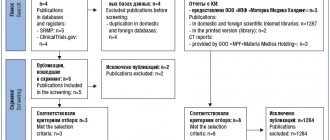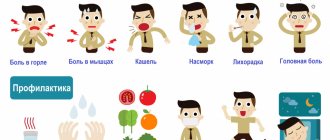Pharmacology
The instructions say that Arbidol belongs to the category of antiviral drugs. Once in the human body, it destroys influenza and coronavirus viruses.
The medication reduces the incidence of complications that can be caused by viruses, and also reduces the incidence of exacerbation of bacterial diseases that occur in a chronic form.
The use of the drug can reduce the duration of the disease. Intended for internal use and has virtually no toxic effects. If you adhere to the specified dosage, then no negative reactions will occur.
Once the active component enters the body, it is quickly absorbed from the digestive system. The maximum content is reached after 1.5 hours. Actively disperses throughout organs and tissues.
Metabolism occurs in the liver. The half-life is approximately 18-20 hours. About 45% of the constituent substances are excreted in their original form, most of them with bile, a small amount through the kidneys. In the first 24 hours, about 85% of the received dose of medication leaves the body.
The use of arbidol for the treatment and prevention of influenza and ARVI in children
The ever-increasing arsenal of drugs used to alleviate the course of infections caused by ARVI covers almost all possible ways of influencing the infectious process and includes immunocorrective, pathogenetic and symptomatic therapy, and virucidal drugs. Among them, one of the leading places belongs to chemotherapy drugs of etiotropic action, which have a direct direct effect on the reproduction of the virus and are aimed at a specific virus-specific target in the viral reproduction cycle. To date, several groups of such drugs have been widely used in the world and in Russia for the treatment and prevention of ARVI. First generation drugs include amantadine and rimantadine [6]. In Russia, amantadine is used only for the treatment of Parkinson's disease; for the treatment and prevention of influenza, its analogue rimantadine is used instead of amantadine. In pediatric practice in Russia, rimantadine is used in the form of a syrup with a special matrix carrier that enhances the anti-inflammatory effect of rimantadine and reduces its toxicity (algirem). It has been shown that the target for amantadine and rimantadine used in influenza virus chemotherapy is the M2 protein of the influenza virus, which forms ion channels in the viral membrane and helps create local changes in the pH gradient necessary for the release of the nucleocapsid and the start of transcription in the early stages of influenza virus reproduction and conformational changes NA of influenza virus in the late stages of viral reproduction [7]. A known fact is the lack of effectiveness of adamantane-type drugs against influenza B viruses, which somewhat limits the use of drugs during the period of epidemic activity of this virus [6]. As epidemiological studies show, recently the circulation of influenza B viruses occurs almost annually, while the influenza B virus was noted as the leading etiological factor in epidemics in the 2001–2002 season, and in subsequent seasons it co-circulated with influenza A (H3N2) viruses. and A(H1N1). Beginning of the 2004–2005 epidemic season. in most regions of the Russian Federation was also associated with the activation of the influenza B virus [2]. The disadvantages of amantadine and rimantadine that limit their use also include the presence of side effects and the rapid development of drug resistance [6,8]. In recent years, a 30-fold increase in the number of naturally circulating strains resistant to rimantadine has been noted in a number of countries (China, Thailand, USA, etc.) [9]. It should also be noted that since 2003, most strains of avian influenza A(H5N1) virus isolated from wild and domestic birds, as well as people infected with this subtype of the virus, have been resistant to rimantadine/amantadine [10]. Currently, in Russia, among the circulating epidemic strains of influenza viruses, about 20% are found to be resistant to rimantadine [11]. It is expected that the percentage of such strains will increase throughout the world in the near future, and this circumstance does not allow relying on amantadine and rimantadine as drugs for the treatment and prevention of influenza. Second-generation drugs include neuraminidase inhibitors: zanamivir, used as nasal drops or aerosol spray, and oseltamivir, used as capsules or tablets [6]. Zanamivir and oseltamivir, created relatively recently through drug design, inhibit the function of the influenza virus enzyme neuraminidase, making it difficult for the release of new viral particles from cells and the further spread of the virus in the body [12]. In pediatric practice, only oseltamivir is used, which is recommended for the treatment of influenza A and B in children over 12 years of age. Until recently, it was believed that the frequency of resistance to oseltamivir among clinical isolates of influenza virus did not exceed 2% and was not a clinical problem. However, recent work suggests that in a pandemic, when taking oseltamivir, the emergence of resistance to this drug may also be significant, since determination of the nucleotide sequence of viruses isolated from children taking oseltamivir revealed mutations responsible for resistance to it in 18% patients [13]. Oseltamivir-resistant viruses were also isolated from two children who became ill with avian influenza (H5N1) and took the drug [14]. Ribavirin and its domestic analogues Arviron and ribamidil are often used in the treatment of ARVI. The exact mechanism of action of these drugs has not been fully established. Ribavirin has been shown to inhibit inosine monophosphate dehydrogenase, which leads to a decrease in the synthesis of guanine triphosphate, which is necessary for viral transcription. It is likely that the drug also interacts with the 5-capped region of mRNA and, as a result, inhibits mRNA transcription. In addition, ribavirin has been shown to inhibit the initiation and elongation of virus-specific RNA polymerase [15]. There is evidence confirming that the drug has an immunomodulatory effect. However, recent studies suggest that the main mechanism providing the virus-specific effect of the drug against RNA-containing viruses is associated with the mutagenic activity of ribavirin, which causes the occurrence of so-called lethal mutations in the genome of these viruses [16]. Ribavirin has been shown to inhibit the reproduction of a number of respiratory viruses (influenza A and B viruses, RS virus, adenoviruses, parainfluenza viruses) in cell culture, but its use in practice for the treatment of these infections has not become widespread [17,18]. In pediatric practice, the drug is used only in the form of inhalations for severe damage to the respiratory system caused by the RS virus. Moreover, due to the high risk of developing serious side effects due to toxicity and the difficulties of standardizing doses when using it in the form of inhalations, ribavirin can only be used in an intensive care unit [6,15,18]. Currently, the domestic drug Arbidol is widely used in Russia. It is an original drug, from a chemical point of view, representing 1-methyl-2-phenylmethyl-3-carboethoxy-4-(dimethylaminomethyl)-5-hydroxy-6-bromoindole hydrochloride monohydrate. Arbidol is recommended by the Pharmacological Committee of the Russian Ministry of Health as a preventive and therapeutic agent for influenza A and B, as well as acute respiratory viral infections (ARVI) of non-influenza etiology for adults and children [19,20]. A study of the mechanism of Arbidol's virus-specific action against the influenza virus showed that the drug acts at the early stages of viral reproduction. Arbidol interacts with the surface protein hemagglutinin (HA) of the influenza virus, increasing its stability to conformational changes induced by low pH, and, as a result, inhibits the process of fusion of the lipid envelope of the virus with endosome membranes, leading to the release of the viral nucleocapsid and the beginning of transcription of the viral genome [21 ,22,23,24]. Along with the virus-specific effect, Arbidol has immunomodulatory, interferon-inducing and antioxidant effects [19,20,25]. In pediatric practice, Arbidol is approved for use in children aged 2 years and older and is used in the form of film-coated tablets of 50 mg and capsules of 100 mg. For the treatment of influenza, Arbidol is recommended for children from 2 to 6 years old, 50 mg, and for children from 6 to 12 years old, 100 mg 4 times a day for 3-5 days; children over 12 years old: 200 mg 4 times a day for 3–5 days. For emergency prevention of influenza, children from 2 to 6 years, 50 mg, from 6 to 12 years, 100 mg, over 12 years, 200 mg 1 time per day for 10–14 days, during seasonal outbreaks of the epidemic, children aged 2 up to 6 years 50 mg, from 6 to 12 years 100 mg, over 12 years 200 mg 2 times a week for 3 weeks. Clinical trials of Arbidol conducted by the Institute of Virology named after. DI. Ivanovsky [26] during three epidemic seasons of 1993, 1994 and 1995. during the rise in the incidence of ARVI and covering 335 children in closed children's groups of schoolchildren aged 6–15 years, showed that when using Arbidol 50 mg 3 times a week for 5 weeks, the total incidence, regardless of the etiology of ARVI, the effectiveness index ranged from 2 .05 to 2.22, and the efficiency coefficient from 51.3 to 55%. It is important to note that in children receiving Arbidol, acute respiratory viral infections, if they occurred, were mild, without fever, were 2-3 days shorter than in the control group, and clinical symptoms were limited mainly to rhinitis and hyperemia of the mucous membrane. The percentage of recurrent diseases in the group of children taking placebo was 4.6–5 times higher than among children receiving Arbidol. These data were confirmed in clinical trials conducted by the Influenza Institute (St. Petersburg) to study the therapeutic effect of Arbidol in 158 children of preschool and school age with influenza caused by various serotypes of the virus, as well as in their combination with ARVI pathogens of non-influenza etiology. The effectiveness of a 5-day course of Arbidol (10 mg/kg in 4 doses) for ARVI in children was 84.8%, there was a significant reduction in the febrile period and intoxication, and the duration of symptoms of laryngotracheitis. The therapeutic effectiveness of Arbidol was most pronounced when it was prescribed early. A reduction in the period of viral antigen release from the nasopharynx was also observed [27]. Clinical trials have also established the high effect of Arbidol in the prevention of influenza infection during epidemic outbreaks of influenza. In a randomized placebo-controlled trial conducted by the Institute. Pasteur with the participation of 155 children in 1995, it was shown that the use of Arbidol (2 times a week for 3 weeks) 2 weeks before the peak incidence of influenza B led to a reduction in the period of illness by 1.8–3.5 days, and the incidence was reduced by 1.2–4 times depending on the age group [28]. The preventive effect of Arbidol was also studied in Ukraine, in a group of 156 children, during the winter season of 2002/2003. Taking Arbidol by children (aged 6 to 12 years, 0.1 g once every 3 days for 4 weeks, over 12 years old, 0.2 g once every 3 days for 4 weeks) helped reduce the incidence of influenza and ARVI 2.6 times, prevented the development of severe forms of the disease, as well as the development of complications [29]. Similar results were obtained in a later clinical trial involving 500 children [30]. In addition to reducing the duration of uncomplicated respiratory infections, when treated with Arbidol in children, a milder course of infections was observed, and, what is especially important, a reduction in the risk of complications. In the group of children suffering from chronic diseases of the respiratory tract, the number of cases among those taking Arbidol was 3.7 times less than in the control group, and the number of acute bronchitis, pneumonia, and otitis was 4 times less than in the control group [30]. Clinical trials of Arbidol in children confirmed its immunomodulatory effect. Thus, in children with initially reduced T-cell immunity, there was a normalization of the quantitative parameters of the T-system, and with an initially normal content of T-cells, the functional characteristics of the T-population were normalized without an increase in the content of the T-population itself. In the group of children receiving a preventive course of Arbidol, the content of serum immunoglobulins also increased with greater frequency and to a greater extent than in the comparison group. It was found that in children taking Arbidol, there was a significant shift in T-lymphocytes towards T-helper cells in comparison with the control group of children (57.1% versus 33.3%, respectively). In sick children, the effect of Arbidol on the phagocytic activity of macrophages was also revealed [27]. There was no inhibitory effect of Arbidol on indicators of humoral immunity, on the production of antiviral antibodies and their level in the blood [26,27,28,31]. Thus, clinical trials of the therapeutic and prophylactic effectiveness of Arbidol in children indicate the high effectiveness of the drug. The most important advantage of Arbidol is the breadth of its spectrum of action. It has been shown that Arbidol inhibits the reproduction of three antigenic subtypes (H1N1, H2N2, H3N2) and remantadine-resistant human influenza A viruses, as well as influenza viruses of the H5 and H9 subtypes, pathogenic for humans and birds, and influenza viruses B and C [32,33, 34]. Arbidol in cell culture inhibits the reproduction of viruses that cause ARVI, such as RS virus and adenovirus type 5, at the level of the drugs ribavirin and ribamidil, which are active against these infections [35], as well as parainfluenza viruses 3 and rhinovirus 14 [36]. Recently, data were obtained on the activity of Arbidol in cell culture and in the Syrian hamster model against coronavirus, which is the causative agent of SARS (SARS) [37]. Confirmation of data on the inhibition of viral reproduction of RSV and adenovirus by Arbidol was obtained in its clinical trials in children. Although direct clinical trials on the effectiveness of Arbidol against infections caused by these viruses have not been conducted, when assessing the preventive and therapeutic effectiveness of Arbidol among children in patients with clinical symptoms of influenza, laboratory methods (immunofluorescence, enzyme immunoassay and serological) revealed the presence of RSV and adenoviruses as in the form of monoinfections and in combination with each other. At the same time, as a result of therapy with Arbidol (3 x 100 mg per day, 5 days), positive dynamics in the course of the disease were noted. There was a significant reduction in the febrile period and intoxication, and the duration of symptoms of stenosing laryngotracheitis. The effect of the drug on the duration of catarrhal symptoms in the nasopharynx and lungs was somewhat less pronounced. With the prophylactic use of Arbidol in children, its effect was also observed in patients with RSV and adenovirus infection, but this effect was weaker than for the influenza virus [19,27]. When studying the effectiveness of Arbidol in the treatment of rotavirus infection in children, an adenovirus antigen was also identified when establishing an etiological diagnosis. After using Arbidol (4 x 50 mg for 5 days), on the 5th day of treatment in 70%, and on the 7th day in almost all patients, it was not possible to detect the adenovirus antigen, while in the comparison group on 5– On days 1 and 7, adenovirus antigen was detected in 15 and 35% of patients, respectively [38]. Arbidol is a low-toxic drug. The drug has no teratogenic, mutagenic, carcinogenic or embryotoxic effects [19]. All clinical trials of Arbidol, conducted over several years, as well as the experience of its use in medical practice, indicate that Arbidol in recommended doses is well tolerated by patients [19,20]. No side effects were noted in children [26–30,38]. Arbidol is quickly absorbed from the gastrointestinal tract, its bioavailability is about 40%. Until now, influenza virus strains resistant to Arbidol have been obtained only in vitro in cell culture [24]. A study of about 100 influenza virus isolates isolated during the epidemic period from 2002 to 2004 in Russia did not reveal any that were initially resistant to Arbidol [39]. Clinical observations conducted among patients during the period of illness also did not reveal the formation of strains of influenza A and B viruses resistant to Arbidol while taking the drug [personal communication]. Currently, there are no effective vaccines for the prevention of ARVI, with the exception of vaccines against influenza A and B, so the use of antiviral drugs for the treatment of ARVI is of paramount importance. The symptoms of these respiratory diseases are similar, and laboratory diagnosis of ARVI is not yet widespread in practice. However, the antiviral drugs currently used to treat these infections have a rather narrow spectrum of action. Anti-influenza drugs of the adamantane series are effective only against the influenza A virus; zanamivir and oseltamivir were developed as inhibitors of the active site of neuraminidase of the influenza A and B viruses, and accordingly are highly selective inhibitors of the reproduction of only the influenza A and B viruses. The breadth of the spectrum of action of Arbidol against respiratory viruses serves basis for recommending initiation of treatment without preliminary diagnosis of the disease. This fact, along with the variety of biological activity of Arbidol, expressed in virus-specific, interferon-inducing, immunomodulatory and antioxidant effects, as well as its safety and lack of side effects, make this drug very promising for the treatment and prevention of ARVI in children.
Literature 1. Ershov F.I. Antiviral drugs. Directory. Geotar Medicine, Moscow. 2006.–312 p. 2. Slepushkin A.N., Ivanova V.T., Burtseva E.I. and others. Research results from the Center for Ecology and Epidemiology of Influenza in 1994–2004. Abstracts of the International Conf. “Current viral infections – theoretical and practical. aspects", St. Petersburg. – 2004. – P. 19. 3. L.Kaiser, R.Couch, G.Galasso et al.. First International Symposium on influenza and other respiratory viruses: summary and overview. Kapalua, Maui, Hawaii, December 4–6, 1998. Antiviral Research.– 1999.– 42.– 149–176. 4. Acute respiratory diseases in children: treatment and prevention / Scientific and practical program of the Union of Pediatricians of Russia. – M.: International Foundation for Mother and Child Health. 2002.–69p. 5. Uchaikin V.F.. Guide to infectious diseases in children. – Geotar Medicine, Moscow. 1998.–700 p. 6. Hayden F. WHO Guidelines on the Use of Vaccines and Antivirals during Influenza. Annex 5–Considerations for the Use of Antivirals during an Influenza pandemic, Geneva, 2–4 October, 2002. 7. Hay, A. Amantadine and Rimantadine–Mechanisms. In book: Antiviral Drug Resistance, D. Richman (ed), John Willey and Sons Ltd, UK(1996), 44–58. 8. Belshe, B. Burk, F. Newman et al. Drug resistance and mechanism of action amantadine on influenza A viruses // J. Inf. Dis.– 1989.– 159.–430–435. 9. Bright R., Medina M., Xu X., et al. Incidence of adamantine resistance among influenza A (H3N2) viruses isolated worldwide from 1994 to 2005: a cause fro concern.// Lancet.–2005.– 10. Avian influenza A (H5N1) infection in humans. The writing Committee of the WHO Consultation on human influenza A/H5.// N. Engl. J. Med.– 2005.– V. 353.– P. 1374–1385. 11. Shevchenko E.S., Burtseva E.I., Slepushkin A.N. et al. Spectrum of sensitivity to rimantadine of influenza A viruses circulating in the epidemic seasons of 2002–2004 // Issue. Virol.–2005.–N.5.–P.32–35. 12. Laver, W. G., Bischofberger, N., Webster, R. G. Disarming Flu Viruses.// Scientific American.– 1999.– 280:– 78–87 13. Kiso M., Mitamura K., Sakai–Tagawa Y. et al. Resistant influenza A viruses in children treated with oseltamivir: descriptive study// Lancet.–2004.– 364:– 759–765. 14. Le Q., Kiso M., Someya K., et al. Avian flu: isolation of drug-resistant H5N1 virus // Nature.–2005.–438.–P.754. 15. FDA. Antiviral Drug Advisory Committee. Gaithersburg: Center for Drug Evaluation and Research.–2002.–P.1–266. 16. Crotty S., Cameron C., Andino R. Ribavirin's antiviral mechanism of action: lethal mutagenesis? // J.Med.Chem.–2002.–80.–P.86–95. 17. Smith, DW, Frankel, LR, Mathers, LH, et al. A controlled trial of aerosolized ribavirin in infants receiving mechanical ventilation for severe respiratory syncytial virus infection// N.Engl.J.Med.– 1991.– 325.–24–29. 18. Stein, DS, Creticos, CM, Jackson GG, et al. Oral ribavirin treatment of influenza A and B.// Antimicrob.Agents Chemother.– 1987.– 31.–1285–1287. 19. Guskova T.A. and Glushkov R.G. Arbidol is an immunomodulator, interferon inducer, antioxidant. Moscow (1999). 20. Glushkov RG Arbidol. Antiviral, Immunostimulant, Interferon inducer..Drug of the Future 1992; 17:1079–81 21. Glushkov R.G., Fadeeva N.I., Leneva I.A. and others. Molecular biological features of the action of arbidol, a new antiviral drug. // Chemical and pharmaceutical journal. – 1992. – 2. – 8–15 22. Fadeeva N.I., Leneva I.A., Panisheva E.K. . and others. Inhibitors of the early stages of virus-cell interaction among 3-carboxy-5-hydroxy-6-bromoindole derivatives. // Chem.-pharm. magazine. – 1992. – 9. – 9–11. 23. Leneva I.A., Fadeeva N.I., Fedyakina I.T. and others. The use of enzyme-linked immunosorbent indication of virus-specific antigens in the study of the new anti-influenza drug Arbidol. // Chemical and Pharmaceutical Journal. – 1994. – 9: – 4–8. 24. Leneva, I., Hay, A. The mechanism of action of arbidol against influenza virus–selection and characterization of arbidol–resistant mutants 2002 12th International Congress of Virology, Paris, Abs.1077 25. Glushkov R.G., Guskova T.A., Krylova L.Yu., Nikolaeva I.S. Mechanisms of the immunomodulatory action of arbidol.// Bulletin of the Russian Academy of Medical Sciences.–1999.–3.–36–40. 26. Belyaev A.L., Burtseva E.I., Slepushkin A.N. and others. Arbidol is a new drug for the prevention of influenza and acute respiratory viral infections in children //. Bulletin of the Russian Academy of Medical Sciences. – 1996. – 3. – 34–37. 27. Drinevsky V.P. Osidak L.V. Natsina V.K. and others. Chemotherapy in the treatment of influenza and other respiratory viral infections //. Antibiotics and chemotherapy. – 1998. – 9. – 29–34. 28. Kubar O.I., Stepanova L.A., Safonova L.S., Rozaeva N.R. Clinical application of the immunomodulatory properties of arbidol in ARVI.–IV Russian National Congress 'Man and Medicine', 1997; 269 29. Kramarev S.A., Palatnaya L.A., Litus V.I. Experience of using arbidol in the treatment and prevention of influenza and acute respiratory viral infections in children in Ukraine.//RMZh.–2003.–21.–1050–1051. 30. Uchaikin V.F., Kharlamova S.G., Cheshik S.G. and others. The use of arbidol and amixin as etiotropic therapy for influenza and ARVI in children // Pediatrics. – 2004. – 5. – 73–77. 31. Guskova, TA, Nikolaeva, IS, Zacharova, NG Experimental and clinical study of arbidol, an antiviral drug. 9th Mediterranean Congress of Chemotherapy, 1994, Abs.82 32. Leneva I.A., Fedyakina I.T., Guskova T.A. and others. Sensitivity of various strains of influenza virus to arbidol. Study of the effect of arbidol on the reproduction of influenza A virus in combination with various antiviral drugs // Therapeutic archive. – 2005. – No. 8. – pp. 84–88. 33. Fedyakina I.T., Leneva I.A., Yamnikova S.S. and others. Sensitivity of influenza A / H5 viruses isolated from wild birds in Russia to arbidol in MDCK cell culture // Questions of Virology. – 2005. – No. 6. – P.22–25 34. Lvov D.K., Fedyakina I.T., Shchelkanov M.Yu. and others. The effect of in vitro antiviral drugs on the reproduction of highly pathogenic strains of influenza A/H5N1 virus, which caused an epizootic among poultry in the summer of 2005. // Issues of Virology. –2006.–№2.–S. 15–18. 35. Leneva I.A., Fedyakina I.T., Sokolova M.V., Guskova T.A. Using an enzyme-linked immunosorbent assay to study the effect of an antiviral drug on the reproduction of respiratory syncytial virus. // Issues of Virology. – 2002– 2.– 42– 45. 36. Brooks M. Studies with the antiviral drug Arbidol. Materials of the candidate's dissertation. 2003–Australia, Melbourne.140p. 37. Khamitov R.A., Shuster A.M., Loginova S.Ya. and others. Experimental data on the effectiveness of arbidol against the causative agent of atypical pneumonia (SARS) in vitro and in vivo. In the collection: Arbidol – new data, pp. 43–46. M., 2004. 38. Uchaikin V.F., Novokshonov A.A., Tikhonova O.N. and others. Antiviral drug arbidol as a prospect for etiotropic therapy of rotavirus infection in children. // Children's infections. – 2004. – 8. – 34–39. 39. Burtseva E.I., Shevchenko E.S., Leneva I.A. and others. Sensitivity of influenza A and B viruses to rimantadine and arbidol, which caused epidemic increases in incidence in Russia in the 2004–2005 season. // Issues of Virology. – 2006. – Accepted for publication.
Why take Arbidol
The main indication for use of the product is the treatment of viral diseases. Also used for preventive purposes.
The product is effective for the following diseases:
- ARVI;
- flu;
- bronchitis and pneumonia (as part of complex therapy);
- respiratory syndrome in severe acute form.
The product can also be used to prevent possible complications associated with the appearance and spread of infection after surgery, to stabilize the patient’s immunity.
“Polyclinics are completely abandoning patients”
Siberian Ekaterina
At the end of June I received a positive PCR result for coronavirus. A therapist came to her home and prescribed a number of medications:
- “Coronavir” - the therapist said that it seems like they should give it out, but the clinic doesn’t have it, so “buy it yourself,” the cost for a course of treatment is almost 12 thousand rubles. "Grippferon", the glucocorticosteroid "Metypred" and the blood-thinning drug "Xarelto". The last two drugs were brought from the clinic, but after I called the manager.
At the same time, she notes that her husband was also swabbed on the day when Catherine received a positive test, and, despite symptoms similar to coronavirus, they did not begin to treat him:
“Now I understand why there are so many seriously ill patients: we are being neglected at the primary care level, clinics are completely abandoning patients.
Then, 12 days after taking it, they found out that my husband’s smear was also positive, but he was not given free medicine.
“I called the deputy chief physician and asked if blood thinners were available, since they are also an integral part of our treatment. My husband and I drank Xarelto and finished “my” jar. The deputy said that these drugs were not available. I had to buy it myself, and the cost starts from 3,500 rubles. So only on TV and from the mouths of officials are outpatients provided with medications. In practice, everything is completely different, unfortunately.







